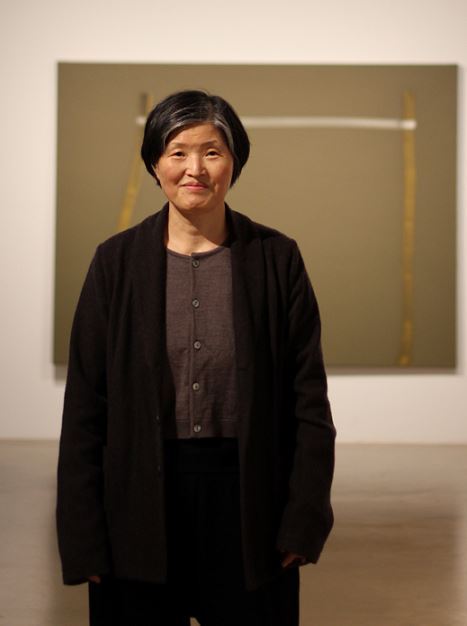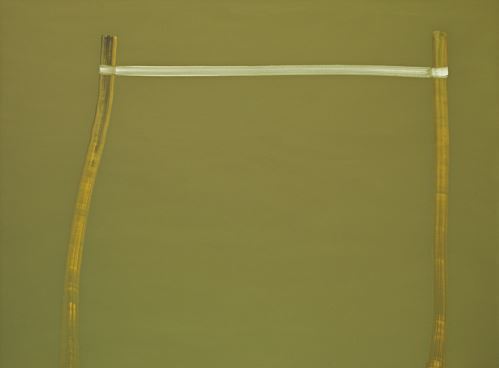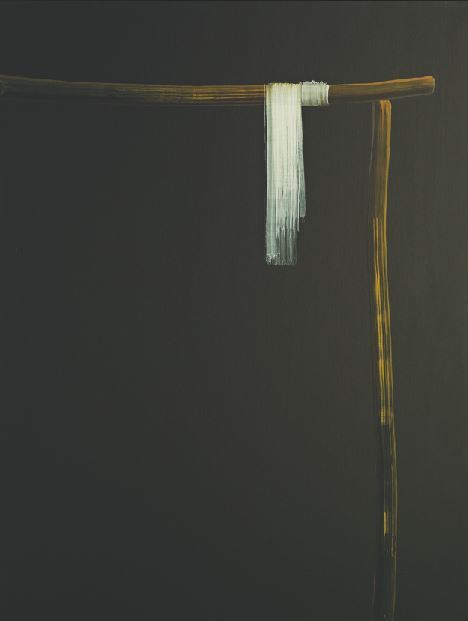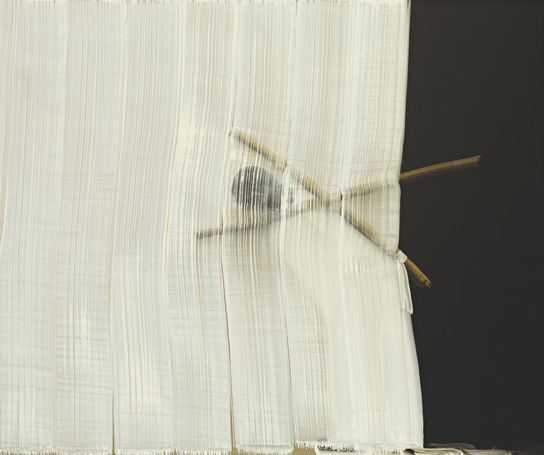Nostalgia-infused brushstrokes
German-based artist Song Hyun-sook expresses longing for her hometown through simple objects of traditional Korean life
By Lee Woo-youngPublished : Dec. 1, 2014 - 20:37
The Korean woman in a traditional white dress with delicately pulled-back hair is seen through a long ramie veil with ripples created by wooden sticks. Viewers can’t get a firm grasp of the mysterious figure behind the veil, but those familiar with traditional Korean life would start to feel the nostalgia of the old lifestyle through simple objects such as a laundry paddle used to wash clothes and fabrics made at home.
This painting symbolizing traditional rural life in Korea was made by artist Song Hyun-sook, who is based in Hamburg, Germany, almost halfway around the world from Korea.
Song has been living abroad for 44 years. She went to Germany in 1972 to work as an assistant nurse to make money when Korea was a poverty-stricken nation. Under a migrant worker agreement between South Korea and Germany, nearly 10,000 South Korean nurses and a large number of miners were dispatched to Germany. Some returned to Korea after finishing their contracts, but some stayed back, got married and started a family there like Song.
“I was 22 when I went to work in Germany. I worked for four years as a nurse. When I worked at a psychiatric hospital, there was an art therapy session. I liked to paint since I was young, but it revived my interest in art hidden inside me,” Song said at Hakgojae Gallery in Seoul, where her exhibition is underway.
This painting symbolizing traditional rural life in Korea was made by artist Song Hyun-sook, who is based in Hamburg, Germany, almost halfway around the world from Korea.
Song has been living abroad for 44 years. She went to Germany in 1972 to work as an assistant nurse to make money when Korea was a poverty-stricken nation. Under a migrant worker agreement between South Korea and Germany, nearly 10,000 South Korean nurses and a large number of miners were dispatched to Germany. Some returned to Korea after finishing their contracts, but some stayed back, got married and started a family there like Song.
“I was 22 when I went to work in Germany. I worked for four years as a nurse. When I worked at a psychiatric hospital, there was an art therapy session. I liked to paint since I was young, but it revived my interest in art hidden inside me,” Song said at Hakgojae Gallery in Seoul, where her exhibition is underway.

Song decided to go to an art college and applied to the College of Fine Arts in Hamburg. She began a new life as an art student while working part-time at hospitals during summer and winter breaks.
Song returned to Korea briefly after graduation on an academic exchange program with a South Korean university. She studied traditional Korean art at Chonnam National University for a year and rediscovered the beauty of traditional objects that she was familiar with.
She was born in one of the most underdeveloped rural villages, Damyang in South Jeolla Province, not far from where she later studied art. She grew up watching her mother spinning thread from raw cotton and weaving cloth with a loom. For six years, she had to walk more than an hour to get to the nearest elementary school.

“It was the most eco-friendly lifestyle from the environmental perspective. Everything was made from scratch to support our daily life,” said Song.
The ordinary tools used at her old home have reemerged in her paintings, but this time they are combined with her deep longing for her hometown. Song paints wooden sticks used to hang or support the ramie veils her mother made at home, a ceramic jug and rubber shoes that women frequently wore at home.
For the new exhibition, she is presenting a painting inspired by the 2014 Sewol ferry disaster in South Korea. The white cloth and wooden sticks vanish toward the end as if the life and hopes of the victims are disappearing with the sinking ship in the deep cold water.


The titles of her paintings are based on the number of strokes she used to complete them. These range from three to 28, depending on the number of objects in her paintings. Usually it takes five to seven strokes ― a surprisingly low number for such delicate images.
She uses the coarse, stiff-bristled brush called the “gwiyal” that has been used since the Joseon era (1392-1897) and carefully applies paint to each end to create her images.
“It’s the style I have been actively pursuing since 1995. I have to be good at drawing lines. If I don’t practice drawing lines ― even for one day ― it shows (through) a lack of clarity and precision in my painting,” said Song.
The exhibition “Breath and Brushstrokes” continues through Dec. 31 at Hakgojae Gallery on Samcheongno, Jongno-gu, Seoul. For more information, call (02) 720-1524.
By Lee Woo-young (wylee@heradlcorp.com)








![[Graphic News] More Koreans say they plan long-distance trips this year](http://res.heraldm.com/phpwas/restmb_idxmake.php?idx=644&simg=/content/image/2024/04/17/20240417050828_0.gif&u=)
![[KH Explains] Hyundai's full hybrid edge to pay off amid slow transition to pure EVs](http://res.heraldm.com/phpwas/restmb_idxmake.php?idx=644&simg=/content/image/2024/04/18/20240418050645_0.jpg&u=20240419100350)





![[From the Scene] Monks, Buddhists hail return of remains of Buddhas](http://res.heraldm.com/phpwas/restmb_idxmake.php?idx=652&simg=/content/image/2024/04/19/20240419050617_0.jpg&u=20240419175937)

![[KH Explains] Hyundai's full hybrid edge to pay off amid slow transition to pure EVs](http://res.heraldm.com/phpwas/restmb_idxmake.php?idx=652&simg=/content/image/2024/04/18/20240418050645_0.jpg&u=20240419100350)

![[Today’s K-pop] Illit drops debut single remix](http://res.heraldm.com/phpwas/restmb_idxmake.php?idx=642&simg=/content/image/2024/04/19/20240419050612_0.jpg&u=)